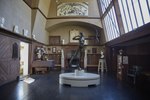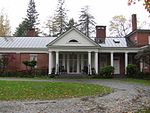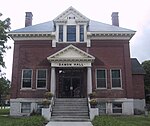Plainfield Town Hall
Buildings and structures completed in 1846Buildings and structures in Sullivan County, New HampshireCity and town halls in New HampshireCity and town halls on the National Register of Historic Places in New HampshireGreek Revival architecture in New Hampshire ... and 2 more
National Register of Historic Places in Sullivan County, New HampshirePlainfield, New Hampshire

Plainfield Town Hall is one of two town halls in Plainfield, New Hampshire. This town hall stands on New Hampshire Route 12A, north of its junction with Daniels Road. Built in 1846 using timber from an earlier town hall, it is a good example of vernacular Greek Revival architecture. It is further notable for the artwork on its stage backdrop, executed by Maxfield Parrish. The building was listed on the National Register of Historic Places in 1985.
Excerpt from the Wikipedia article Plainfield Town Hall (License: CC BY-SA 3.0, Authors, Images).Plainfield Town Hall
Daniels Road,
Geographical coordinates (GPS) Address Nearby Places Show on map
Geographical coordinates (GPS)
| Latitude | Longitude |
|---|---|
| N 43.535555555556 ° | E -72.354722222222 ° |
Address
Daniels Road 9
03781
New Hampshire, United States
Open on Google Maps









